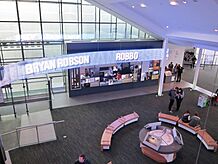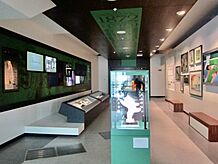National Football Museum facts for kids
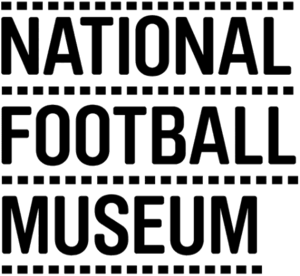 |
|
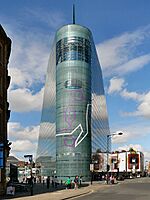
Exterior of the museum in 2012
|
|
| Established | February 2001 |
|---|---|
| Location | Urbis, Manchester (2012–) Deepdale, Preston (2001–2010) |
| Type | Sports museum |
| Visitors | 574,000 (2016) |
| Public transit access | Manchester Victoria Exchange Square Metroshuttle |
The National Football Museum is England's special museum dedicated to football. It is located in the Urbis building in the heart of Manchester. This museum keeps, protects, and shows off amazing collections of football items.
The museum first opened in Deepdale, Preston, Lancashire. But in 2012, it moved to its current home in Manchester.
Contents
The Museum's Story
How the Museum Started
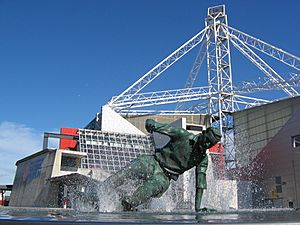
The idea for the National Football Museum began way back in 1994. A company called Baxi Partnership bought the Preston North End Football Club (PNE). They started to rebuild the Deepdale Stadium. During this time, Bryan Gray, who was the Chairman of PNE, talked with the Football League. This led to a meeting with Harry Langton. Harry had spent over thirty years collecting what is now known as the FIFA Museum Collection.
FIFA understood how important this collection was. They bought it from Harry Langton, hoping to find a permanent home for it. FIFA thought the planned museum in Preston would be the perfect place for their collection.
Bryan Gray put together a small team to work on the museum project. This team included people from FIFA, museum directors, and university leaders. The Football Association also helped. The National Football Museum officially became a company in June 1995. It then became a registered charity in November 1995.
The Preston Years
After a lot of hard work, the museum received a large grant of £7.5 million from the Heritage Lottery Fund in November 1997. The museum was planned to be inside the Bill Shankly Kop stand at Deepdale. The total cost of the project was about £12 million.
A special ceremony to start building took place on September 26, 1998. Important people like Sepp Blatter from FIFA and the Secretary of State for Culture, Media and Sport attended. The foundation stone was laid in April 2000. Finally, the National Football Museum officially opened on June 21, 2001, with the Duke of Kent present.
Kevin Moore became the museum's Director in August 1997. The museum's first location was outside Deepdale, Preston. Deepdale is a very special place because it is the oldest professional football ground in the world that has been used continuously.
In 2003, the museum and the University of Central Lancashire started the International Football Institute. This group does research into the history, social impact, and culture of football.
Many famous football figures praised the museum. In 2004, Sepp Blatter, the President of FIFA, called it "a superb realisation, a real jewel!" Sir Bobby Charlton said he "can't think of a better museum anywhere in the world." Sir Alex Ferguson also said he was always impressed by how well the museum brought football's rich history to life. The museum even won an award in 2005 for being the Large Visitor Attraction of the Year.
Moving to Manchester
Even though the museum was praised and attracted 100,000 visitors each year, getting enough money was always a challenge. In 2009, the museum's leaders talked to Manchester City Council about moving. The city council offered to give the museum £2 million each year if it moved to Manchester.
Preston and Lancashire councils tried to keep the museum by offering £400,000 per year. However, the museum's leaders voted to move it to the Urbis exhibition centre in Manchester.
The plan was to keep the Preston site open as a smaller centre if they could get enough funding. But the museum could not agree on a funding plan with Lancashire County Council. So, the Preston site closed to the public at the end of April 2010. In 2023, the old Preston site reopened as a fan zone called 'The Gentry Bar'.
The Urbis building closed in February 2010 to get ready for the new National Football Museum. The museum reopened in Manchester on July 6, 2012. The new museum hoped to attract 350,000 visitors each year. It quickly became very popular. By August 2012, over 100,000 people had visited in just six weeks. By April 2013, the museum had already reached its goal of 350,000 visitors. By 2017, it was attracting 500,000 visitors annually. Since January 2019, the museum has charged an entry fee, but it remains free for people who live in Manchester.
What You Can See: Museum Layout
The museum is inside the Urbis building and has exhibits spread across four floors.
Pitch Gallery
This is the largest floor and has several exciting areas:
- Trophies: Here you can see copies of the FA Cup and Premier League trophies.
- Hall of Fame: This area lists all the famous players and people who have been added to the museum's Hall of Fame.
- Changing Exhibitions: This space features different art displays and special shows that change over time.
Match Gallery
This is another large floor with many interesting zones:
- The Game: This section shows important items like the very first rule book from 1863. You can also see the shirt from the first ever international football match between England and Scotland.
- Fans: This area includes the famous painting "Going to the Match" by L.S. Lowry.
- Competition: Learn about different football competitions and leagues. You can see the original version of the FA Cup and many replica trophies.
- England on the World Stage: This part is all about the England men's and women's national teams. It features the Jules Rimet Trophy, the match ball from the 1966 World Cup Final, and Diego Maradona's "Hand of God" shirt.
- Stadiums: Discover information about different football stadiums and their designs. You can even see an original turnstile from the old Wembley Stadium and some old wooden seats.
- Media: Watch old match footage and see news clippings. There's even a sheepskin coat worn by famous commentator John Motson.
- Clubs: Use interactive screens to find information about most league clubs in England.
- Players: Take a quick look at different types of footballers. This section includes the only Victoria Cross won by a professional footballer.
- Our Beautiful Game: Watch a 10-minute film in a cinema that shows a month in English football at all levels.
Play Gallery
This gallery has fun, interactive football games you can play. It also includes these zones:
- Football for All: This area shows how football is played by people of all abilities.
- Laws: Interactive screens explain the original rules of football and the roles of referees.
- Managers: Listen to audio clips from famous managers and see the original Manager of the Year trophy.
- Toys and Games: A display of various football-related games and toys.
- Performance: Learn about the medical side of playing football.
- Discovery Zone: A special area for children under 5 to play.
Score Gallery
This is a space for changing exhibitions. In summer 2016, it had a display celebrating 50 years since England won the World Cup. From 2018 to 2019, it hosted "The Game: Thirty Years Through the Lens of Stuart Roy Clarke".
Learning and Education Zone
This is a special area designed for school groups and educational visits.
Amazing Collections
The museum has many important collections. These collections are kept at its research facility, which was once located at the Deepdale stadium in Preston. The museum was open there from June 2001 to March 2010.
Here are some of the collections the museum holds:
- The FIFA Museum Collection
- The Football Association Collection
- The Football League Collection
- The FIFA Book Collection
- The People's Collection
- The Football Clubs Collection
- The Harry Langton Collection
- The Sir Stanley Matthews Collection
- The Littlewoods Collection
- The Priory Collection
- The Neville Evans Collection
The Neville Evans collection is part of the largest private collection of football items in the world. It is also known as the National Football Collection. It includes many different football-related things, like the biggest private collection of Tottenham Hotspur items. At least 400 items from this collection are on long-term loan to the National Football Museum. Other items are also used to help with their displays and traveling exhibitions. Neville Evans, a UK businessman, started this collection. It continues to grow and helps to save and share the history of football for future fans.
- The Homes of Football – amazing photographs by Stuart Roy Clarke
At any time, about 2,500 items from the museum's collections are on display in Manchester. The museum holds about 140,000 more items in total.
Some of the most important items include:
- Both of the two balls used in the first World Cup Final in 1930.
- The ball from the 1966 World Cup Final.
- A copy of the Jules Rimet Trophy. This copy was secretly made by the FA in 1966 after the original was stolen. England players showed off this copy at the 1966 World Cup Final.
- The jersey and cap worn by the England captain in the world's first official international football match, Scotland vs England, in 1872.
- The world's oldest women's football kit, from the 1890s.
- The shirt worn by Maradona during his famous 'Hand of God goal' and 'The Goal of the Century'.
- The original rules of association football. These rules were written down when The Football Association was formed in 1863 in London.
Images for kids
-
The original 'Laws of the game' written for The Football Association in 1863
-
The oldest surviving FA Cup trophy (1896-1910)
-
Football used in the 1930 World Cup Final, chosen by the Argentine team
Special Exhibitions
The museum often loans out many of its exhibits to other museums in the UK. Its artifacts have also been shown in exhibitions in Germany, Portugal, Switzerland, and Belgium. The museum has worked with UEFA to create special exhibitions. One was the UEFA Jubilee Exhibition, which opened in the European Parliament in Brussels before coming to the National Football Museum.
The museum also worked with UEFA to create the world's first exhibition just for women's football. This happened at the same time as the UEFA Euro 2005 Women's Championship. For the 2006 FIFA World Cup, the museum helped create exhibitions in Hong Kong and Germany. A special exhibition called "Saved for the Nation: The Story of the FA Cup" opened in May 2006. It featured the oldest surviving FA Cup trophy, which was used in FA Cup Finals between 1896 and 1910.
The museum's temporary exhibitions have included:
- "One for All: All for One" (March to June 2007): A photo exhibition showing the experiences of a disabled Crystal Palace fan.
- "The Greater Game: Football and The First World War" (December 2014): This exhibition looked at football's role during the war. It explored famous stories, including a diary about the Christmas Truce of 1914.
- "Out of Play: Technology in Football" (May 2015)
- "Ferenc Puskás: The World's Greatest Goalscorer" (September 2015)
- "Pitch to Pixel: The World of Football Gaming" (October 2015 to June 2016)
- "1966 World Cup Exhibition" (June 2016 to April 2017)
- "Pelé: Art Life Football" (May 2017 to March 2018)
- "The Game: Thirty Years Through the Lens of Stuart Roy Clarke" (March 2018 to March 2019)
- "Strip! How Football Got Shirty" (November 2019 to June 2020)
- "Admiral 50 Years of Inventing Replica" (June 2024 to July 2024)
More to Explore
- English Football Hall of Fame, which is located at the museum.



